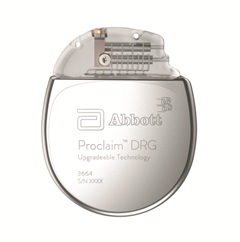
Abbott has announced the launch of its neuromodulation business’ next-generation delivery system, which will be used to streamline the implantation process for electrodes used as part of the company’s Proclaim dorsal root ganglion (DRG) neurostimulation system.
The new system is intended to streamline the procedure whereby doctors implant the system in patients who are suffering from complex regional pain syndrome (CRPS) Type 1 and causalgia (CRPS Type 2) of the lower extremities—rare conditions that, according to an Abbott press release, are considered “more painful than childbirth or limb amputation”.
Abbott has developed Proclaim DRG therapy specifically to target the DRG, which is a cluster of nerve cells found along the spine that control pain signals from certain areas of the body. Proclaim is the first and only DRG technology approved to treat CRPS of the lower limbs, the company claims.
The DRG neurostimulation system consists of an implantable pulse generator (IPG) that produces the electrical stimulation and leads that deliver the stimulation to a targeted area. Once implanted, targeted stimulation in the area of the DRG can help address symptoms by disrupting pain signals before they can reach the spinal cord or brain.
Four out of five people using Abbott’s Proclaim DRG neurostimulation system for their CRPS have reported significant pain relief, with an average reported drop in pain intensity of 81%, the company further claims.
Abbott’s recent release states that the delivery system is an important part of the Proclaim DRG system because it enables physicians to carefully navigate and access the precise anatomy of the DRG when placing the system’s electrodes. Designed for ease of use, the next-generation delivery system offers enhanced durability and manoeuvrability, which can streamline the implant procedure, the release notes.
“Because of the distinct position of the dorsal root ganglion near the spinal cord, it can be challenging to proficiently place leads there, which can limit the number of physicians who feel comfortable performing this procedure,” said Timothy Deer (Spine and Nerve Centers of the Virginias, Charleston, USA). “The improved design of the new delivery system enhances manoeuvrability for physicians—potentially allowing more patients to experience the life-changing benefits of DRG stimulation.”
“Research shows treating CRPS with targeted DRG neurostimulation results in significantly better outcomes in terms of pain relief and functional improvements than traditional spinal cord stimulation [SCS] approaches,” said Allen Burton, medical director of neuromodulation at Abbott. “Abbott is continually working to improve DRG technology to better assist physicians in improving patient outcomes. The easier the procedure, the more patients will benefit from it, helping them to live more active, fuller lives with their chronic pain under control.”









